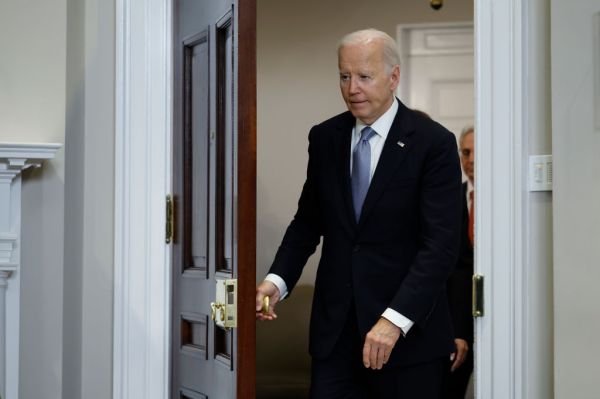Republicans have long branded themselves as deficit hawks. From the floor of Congress to the screens of Fox News to candidate town halls and rallies, they attack “Joe Biden’s spending and deficits” and pledge to cut spending, reduce waste, and balance the budget. Nearly all of this talk should be dismissed until the Republican Party, which I have advised for years, finally backs up this rhetoric with a serious yet plausible anti-deficit agenda.
Republicans claim that their party would cut taxes, slash spending even more, and balance the budget if only those tax-and-spend Democrats would get out of the way. However, even when Republicans sweep elections, they tend to drastically expand budget deficits with tax cuts and new spending. A cynic may consider that Republican lawmakers complain endlessly about surging deficits to obscure their own continued responsibility for them.
Annual budget deficits have surpassed $2 trillion, and they’re on their way to $3 trillion within a decade. The Congressional Budget Office forecasts about $119 trillion in budget deficits over the next 30 years—$116 trillion of which is attributable to Social Security and Medicare shortfalls—and that’s under a rosy scenario of expiring tax cuts, no new spending initiatives, and low interest rates. As the following sections explain, any party that truly cares about restraining runaway deficits—rather than just using them as a cudgel to attack the other party—must stop voting for expensive new policies, and it must put Social Security, Medicare, and middle-class taxes on the table.
I’ve worked for and with Republican lawmakers for 25 years, and believe they have the potential to present solutions that avert a debt crisis. First, however, they need to come to terms with some harsh truths about their own role in getting us to this point—and they need to back up their deficit-hawk rhetoric with a more serious and substantive agenda.
Republicans Drove Up Deficits, Too
The national debt held by the public has soared from $3 trillion to $27 trillion since 2000, and nearly all of this debt has both Democratic and Republican fingerprints on it. For the GOP, Presidents George W. Bush and Donald Trump both cut taxes substantially, and the vast majority of President Obama’s $5 trillion in legislated deficit expansions consisted of GOP-supported tax cut extensions. Republicans have added trillions in defense spending since 9/11, enacted a new Medicare drug entitlement, expanded education spending and farm subsidies, and teamed up with Democrats to spend trillions on stimulus and recession relief from 2011-2013 and again in 2020. Even when Republicans last enjoyed a unified government (the House, Senate, and presidency) in 2017 and 2018, they did nothing to rein in soaring entitlement costs and instead busted the discretionary spending caps by 13 percent in one year. Outside of the 2011 Budget Control Act that capped discretionary spending (and was quickly weakened), there has been no serious Republican effort to rein in spending or deficits in nearly 30 years. (Democrats also voted for virtually every spending increase, and added trillions more when they controlled the government in 2009-2010 and 2021-2022).
Republicans have justified their red ink with three arguments. First, that Democrats are to blame for blocking GOP deficit-reduction initiatives—a case that collapses under the weight of the GOP spending sprees during their periods of unified government. Second, the 2017 tax cutters asserted that, since runaway entitlement costs are the real deficit driver, fundamentally reforming those programs would make even trillion-dollar tax cuts easily affordable. Of course, those accompanying entitlement reforms never came.
And finally, Republicans argue that their tax cuts fully pay for themselves in new revenues from economic growth. This assertion incorrectly assumes that the pre-cut tax rates were already above the revenue-maximizing rate, and that every dollar in tax cuts adds at least $5 in economic output (taxed at an average 20 percent rate to recover that dollar in tax cut revenue losses). While tax cutters will point to rising tax revenues as evidence of “free” tax cuts, even a stable tax code will produce rising revenues simply because of inflation, population growth, rising real wages, and business profits. Nearly all tax cuts reduce revenues relative to this stable tax code, and therefore produce a higher budget deficit than without those tax cuts.
Republicans Lack Serious Proposals to Rein in Deficits
Republicans concede that previous GOP lawmakers failed to back up their anti-deficit rhetoric with enacted legislation. Yet even today’s GOP lawmakers largely fail to offer even a coherent proposal to rein in spending, much less do anything to carry it out. As stated above, Social Security and Medicare shortfalls are responsible for 97 percent of projected budget deficits over the next 30 years. Without reforming those two entitlement programs, there is no package of remotely plausible alternative spending cuts or tax hikes that could cover this shortfall.
Nevertheless, Donald Trump, Ron DeSantis, and the majority of elected Republicans have surrendered to the Republican Party’s increasingly older, populist, working-class voter base by explicitly opposing any significant Social Security and Medicare savings. The GOP also regularly demands defense and veterans’ spending expansions. All together (and including largely untouchable interest costs), Republicans have taken off the table roughly 75 percent of all projected spending a decade from now, and—combined with pledges to extend the 2017 tax cuts—made it mathematically impossible to balance the budget even if the rest of the federal government was eliminated.
Instead, even the most conservative Republicans offer gimmicks and “magic asterisks.” The House GOP budget resolution claims to balance the budget within a decade with no significant changes to Social Security and Medicare. How so? By assuming: 1) a sudden, substantial surge in economic growth; 2) a decline in interest rates that largely contradicts that economic growth surge; 3) an inexplicably zero-cost extension of the 2017 tax cuts; and 4) the largely unspecified elimination of one-third of all other projected spending within a decade (this figure rises to nearly half if defense and veterans’ spending are also exempted as suggested). Those remaining spending savings remain largely unspecified because most Republicans would never actually defenstrate themselves by eviscerating programs like Medicaid, school lunches, SNAP (food stamps), earned-income and child tax-credit subsidies, unemployment benefits, education spending, infrastructure, homeland security, border security, federal prisons, and health research. So these budget blueprints function as nothing more than press releases, declaring “we have a plan” without ever specifying or enacting that plan.
That leaves the usual spending targets of foreign aid (less than 1 percent of federal spending), Ukraine aid (a temporary 1 percent of federal spending), eliminating the Departments of Education and Commerce (while retaining most of the underlying programs and thus saving little money), and the ubiquitous “waste, fraud, and abuse.”
The House Freedom Caucus, for all its demands for drastic spending cuts, has produced no comprehensive budget blueprint—and its discretionary spending demands that have paralyzed Congress since last summer would shave just $150 billion off annual budget deficits that are rapidly heading toward $3 trillion. The Republican Study Committee budget offers more specifics but without a legislative push to pass those proposals.
To pick a typical Republican lawmaker, Rep. Josh Brecheen of Oklahoma often warns that the surging national debt endangers America’s entire existence. Yet the deficit-reduction section of his website specifies savings of just $13 billion—or 0.2 percent of the federal budget—not counting his proposed IRS budget cuts that would reduce tax collection enough to add $100 billion in 10-year deficits. Few of Rep. Brecheen’s colleagues offer any more cuts.
Among the remaining GOP presidential candidates, Donald Trump signed into law legislation that added $7.8 trillion to 10-year deficits during his first presidential term. Ron DeSantis has endorsed large tax cuts along with no significant spending savings. Nikki Haley offers specific tax cut proposals but mostly vague spending savings. For all their bold promises, not a single one of their deficit reduction plans would actually reduce the deficit.
It is difficult to take seriously the debt warnings of a party that repeatedly cuts taxes, expands spending, takes 75 percent of federal spending off the table for future savings, and is afraid to specify significant potential cuts to the remaining 25 percent.
Serious Republicans Must Put Taxes on the Table
Let’s be real and admit a simple truth. No politician should be taken seriously on deficits unless they are willing to reform Social Security, Medicare, and—yes—middle-class taxes. Over the next decade, the annual shortfalls from Social Security and Medicare will soar from $500 billion to nearly $2 trillion, and within three decades face an annual shortfall equal to 12 percent of GDP. Democrats must accept that no defense cuts or tax-the-rich policies could close a gap of this magnitude. Republicans must accept that no cuts to foreign aid and social spending could come close to making up the shortfall. Washington’s Social Security and Medicare promises simply exceed the capacity of the economy and political system to finance them.
Long-term debt stabilization will also require higher middle-class taxes. Federal spending is currently 23 percent of GDP, and Social Security, Medicare, and interest costs are projected to push spending to nearly 30 percent of GDP over three decades. Thus, permanently limiting federal spending to 23 percent of GDP would require a heroic overhaul of Social Security and Medicare, while also paring back defense and social spending. Yet there is no plausible path to long-term debt stabilization that maintains tax revenues at the current baseline level of 17 percent of GDP (or 18 percent with the 2017 tax cuts expiring on schedule). While balancing the budget is not realistic, the debt can be stabilized at the current 100 percent of GDP level by pairing 23 percent of GDP in spending with 20 percent of GDP in revenues. That necessary tax increase of 3 percent of GDP, which is roughly $750 billion in today’s economy, cannot be achieved purely by taxing the rich (even the most ambitious and economically destabilizing tax-the-rich agenda would raise closer to 1 percent of GDP). Most of the available tax base resides among the non-wealthy, who will have to supply more new tax revenues.
Beyond the policy arguments, putting taxes on the table is a political imperative. Any fundamental redesign of Social Security and Medicare must be bipartisan to have any credibility with voters and be sustained over the long-term. And this bipartisan GOP effort will have to include significant tax concessions to Democrats, themed around shared sacrifice, as Americans will never accept deeper-than-necessary cuts to their prized benefits just to ensure that billionaires are shielded from any new taxes.
Delay Brings Even Larger Tax Hikes
In private conversations, GOP lawmakers and strategists often dismiss the urgency of a bipartisan budget deficit “grand deal” by asserting that the looming insolvency of the Social Security and Medicare trust funds will eventually force Democrats to desperately initiate such negotiations to avert an automatic 23 percent benefit cut (as required to achieve self-financing) and give Republicans the upper hand. This belief is flawed for two reasons.
First, a GOP that today is afraid to discuss the possibility of benefit changes even far into the future will not suddenly begin playing hardball with an impending 23 percent cut to Social Security benefits. Up that point, general revenues will have been financing more than 20 percent of program benefits (by repaying its trust fund), and lawmakers who do not endorse continued general-revenue funding of the shortfalls after the trust fund hits zero will face a career-ending fury from elderly constituents. Republicans who regularly surrender to public backlashes on the debt limit and government shutdowns are virtually assured of folding when drastic Social Security cuts are at stake.
Second, each year of delay will likely ensure a more tax-heavy final deal. A decade from now, (likely) higher interest rates and a much larger debt will require even greater immediate savings. At the same time, the 74 million retired baby boomers will be too old to absorb benefit changes (or be affected by the eligibility age). By that point, Social Security and Medicare reforms geared toward Generation X or millennials will take many years to ramp up their savings. All of these factors will increasingly leave new taxes as the only option to produce substantial deficit savings quickly and without sharply reducing benefits for retirees in their 70s and 80s. Conservatives would be better off taking an underwhelming deal today than a disastrously tax-heavy deal down the road.
Time to Be Credible
Most Republicans treat dangerously-escalating budget deficits as a rhetorical issue with which to pummel Democrats rather than an economic challenge requiring sacrifice and tough choices. Any party that a) does not consider America’s debt outlook a problem worthy of scaling back its tax cut ambitions and b) immediately takes 75 percent of federal spending off the table has not earned the credibility to brand itself hawkish on deficits.
The first step to credibility is—or should be—obvious: Stop voting for large tax cuts and spending hikes. This means returning to the 1980s and 1990s standard of offsetting new policies that increase deficits. If it cannot be paid for, it should not be passed. Each year, Congress passes dozens of (somewhat) routine appropriations and authorizations that can be modestly pared back. Lawmakers should also drop the gimmick-filled balanced budget pledges that only build unrealistic voter expectations.
With regard to Social Security and Medicare, it is not necessary to lead with a specific package of cuts that will be savaged by the other party and bring a voter backlash. However, responsible lawmakers should begin making the public case that the debt trends are economically unsustainable, generationally immoral, and require that everything—including Social Security, Medicare, defense, and yes, taxes—be put on the table as part of an equitable package of shared sacrifice. The purpose is to make a public case for deficit-reduction and eventually win the other party’s agreement on the nature of the problem and need for compromise. Once that bipartisan buy-in is achieved, both parties can form a special committee or lawmaker commission to begin exploring potential compromises in private, where reform approaches will not be demagogued. Only when both parties have agreed to a package of reforms should it be presented jointly as legislation.
Yes, this is a multi-step process that requires bipartisan cooperation. However, the public will never accept one party dictating and passing its own partisan solution on such controversial policies. And delicate reforms to Social Security, Medicare, and taxes cannot be negotiated in public with dueling bills, speeches, press releases, and social media soundbites. They require privacy so that both sides can freely explore options. The reform model presented here—bipartisan, with compromises worked out privately—successfully achieved the last major entitlement-and-taxes grand deal with the 1983 Social Security reforms, and a version of it brought the 1990 and 1997 bipartisan deficit-reduction deals.
This all requires deciding that $119 trillion in projected deficits over the next three decades—and a debt surpassing 200 percent of GDP—is a problem worth more than empty rhetoric.








Please note that we at The Dispatch hold ourselves, our work, and our commenters to a higher standard than other places on the internet. We welcome comments that foster genuine debate or discussion—including comments critical of us or our work—but responses that include ad hominem attacks on fellow Dispatch members or are intended to stoke fear and anger may be moderated.